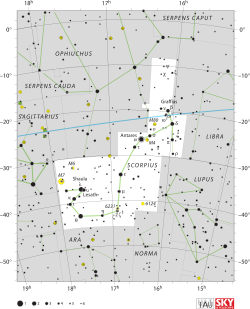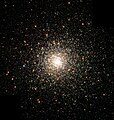Souhvězdí Štíra
| Souhvězdí Štíra | |
|---|---|
 Souhvězdí Štíra | |
| Latinský název | Scorpius |
| Latinský genitiv | Scorpii |
| Latinská zkratka | Sco |
| Rektascenze | 15h 50 m až 18 h 0 m |
| Deklinace | -8,5° až -45° |
| Rozloha | 497 čtverečných stupňů |
| Viditelnost na zeměpisné šířce | +40° až -90° |
| Nejlepší pozorovatelnost v ČR | Červenec |
| Počet hvězd jasnějších než 3m | 9 |
| Nejjasnější hvězda | Antares (α Sco) (0,91m) |
| Sousední souhvězdí | Střelec Hadonoš Váhy Vlk Pravítko Oltář Jižní koruna |
Štír je souhvězdí na jižní obloze. Ve středoevropských zeměpisných šířkách jej lze pozorovat téměř celé s výjimkou nejjižnější části, i tak je spolu se Střelcem jedním ze dvou souhvězdí zvěrokruhu, která zde nikdy nevystoupí nad obzor celá.
Původ jména
Toto souhvězdí představuje štíra, kterého poslala bohyně Artemis na lovce Oriona poté, co na ni lovec zaútočil. Jiná pověst praví, že je to štír, kterého poslala matka Země na Oriona poté, co prohlásil, že vybije všechna nadpřirozená zvířata.
Objekty ve Štírovi
Významné hvězdy
- α Scorpii (Antares) – Červený veleobr a jedna z největších známých hvězd se slabým modrým průvodcem. 700x větší než Slunce. Jasnost se pohybuje mezi 0,9-1,2m. 600 sv. let od Slunce.
- β Scorpii (Acrab) – Dvojhvězda vzdálená asi 1000 světelných let od sluneční soustavy s magnitudou 2,6.
- δ Scorpii (Dschubba) – Zřejmě čtyřnásobný systém vzdálený 400 světelných let od Slunce o jasnosti 2,3m.
- ε Scorpii (Wei) – 65 sv. let vzdálený podobr. 2,3 m.
- ζ Scorpii – Pouhým okem rozlišitelná dvojhvězda – dva rudí obři o jasnosti 4,8+3,6 m.
- λ Scorpii (Shaula) – Podobr o hvězdné velikosti 1,6 m, vzdálený 700 světelných let od Slunce.
Hvězdokupy
- M4 – Velká kulová hvězdokupa o jasnosti 5,9m vzdálená 6 500 světelných let.
- M6 (Motýlí hvězdokupa) – Otevřená hvězdokupa s asi 80 hvězdami, vzdálená 2 000 světelných let. Jasnost je 4,5m.
- M7 – Otevřená hvězdokupa o jasnosti 3,3m. Vzdálenost 2 000 světelných let.
- M80 – Kulová hvězdokupa vzdálená 32 600 světelných let od Slunce, s jasností 7,2m.
Další objekty
Následující objekty mají velkou jižní deklinaci, a proto nejsou pozorovatelné ze střední Evropy a severnějších oblastí:
- NGC 6302 – Jasná planetární mlhovina s magnitudou 9,6.
- NGC 6441 – Jedna z mála kulových hvězdokup, které obsahují planetární mlhovinu. Magnituda hvězdokupy je 7,2.
- NGC 6124 – Jasná a rozsáhlá otevřená hvězdokupa s magnitudou 5,8.
- NGC 6231 – Velmi jasná otevřená hvězdokupa s magnitudou 2,6.
- NGC 6388 – Jedna z nejhmotnějších kulových hvězdokup v Galaxii, magnituda 6,7.
Galerie
- M 4
- M 6
- M 7
- M 80
- Zjevující se Štír
- Kresba od Hevelia
- Kresba Štíra
- Souhvězdí Štíra
Reference
Externí odkazy
Média použitá na této stránce
Autor: Michelet B, Licence: CC BY-SA 3.0
Scorpio & Libra animated constellations
The globular star cluster Messier 4
The en:Scorpius constellation from Uranographia by Johannes Hevelius.
The view is mirrored following the tradition of celestial globes, showing the celestial sphere in a view from "outside"Sternbild Skorpion
Autor: IAU and Sky & Telescope magazine (Roger Sinnott & Rick Fienberg), Licence: CC BY 3.0
IAU Scorpius chart
Autor: Oliver Stein, Licence: CC BY-SA 3.0
Der offene Sternhaufen Messier 7
This stellar swarm is M80 (NGC 6093), one of the densest of the 147 known globular star clusters in the Milky Way galaxy. Located about 28,000 light-years from Earth, M80 contains hundreds of thousands of stars, all held together by their mutual gravitational attraction. Globular clusters are particularly useful for studying stellar evolution, since all of the stars in the cluster have the same age (about 12 billion years), but cover a range of stellar masses. Every star visible in this image is either more highly evolved than, or in a few rare cases more massive than, our own Sun. Especially obvious are the bright red giants, which are stars similar to the Sun in mass that are nearing the ends of their lives.















